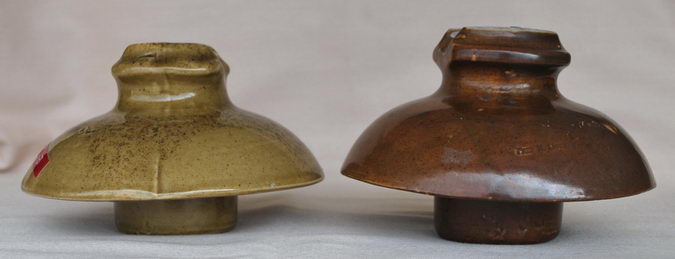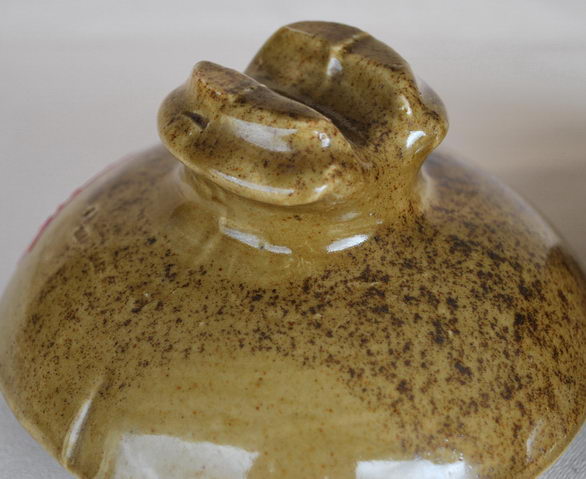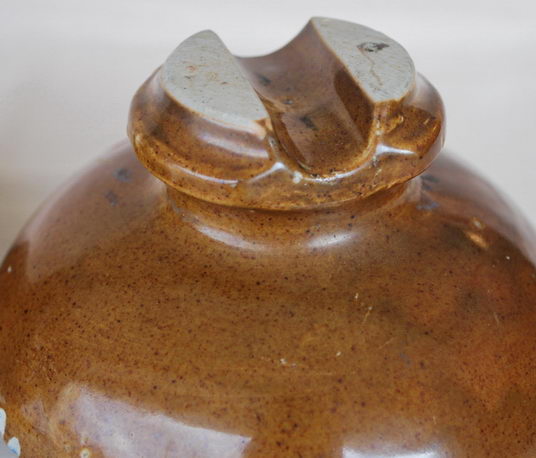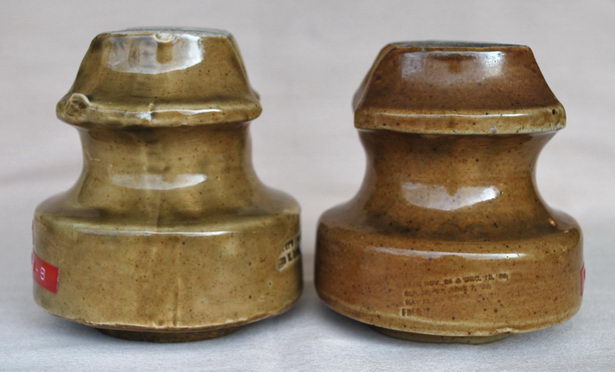
Fred Locke Victor Plant
Evolution of Manufacturing Techniques
Go back to Main Page
Insulator production at the Victor factory during the Fred
Locke era, 1898-1904, can be divided into three distinct periods.
1898-early 1900:
During this period there was extensive experimentation with clay bodies
and glazes as evidenced by the finds from the “Attic Dump” dig and specimens
from the Victor factory dump. The
characteristics of insulators during this period are they were twice fired:
higher temperature biscuit firing for vitrification and lower temperature glost
firing to fuse the glaze to the porcelain body. The firing rest are not filed or fettled but rather wiped
clean of glaze. The markings used
were under-glaze ink #0-5, #6-3, in addition to hand-written ink markings on
some experimental dump specimens.
Early 1900 (addition of new kilns) to late 1901 (prior to plant being destroyed by fire): During this period insulators were single fired to vitrify the clay and set the glaze on the body. Generally the markings used #0-1c, #0-2, #1-5, #1-5a, #1-5b, #1-5c, #1-6, and all the four date markings with VICTOR and manufacturing date on the opposite side, and #6-2. The characteristics of insulators made in this era were the applied, square-shaped crowns on most power styles. The glazes tend to be sandy blonde to sandy brown with slight mahogany hue. The white-glazed pony styles U-38 and U-39 have unglazed pinholes including those with the ‘GLEN’ marking. Firing rests were filed or fettled. The number of styles shown in their catalogs were rather small, but larger than previous catalogs and the first time cemented multiparts were offered known as the “Victor” 300 series which included gutter styles with or without glass bases. The large undated glass bases for M-2795’s were only manufactured only during the year 1900. The glass bases with patent dates were first made in late November or early December 1900. This has been confirmed by archaeological digs by Paul Greaves’ observations of hundreds of broken and whole specimens in northern California.
January 1902 (rebuilt factory) to late 1904: During this period there was a rapid expansion of the power industry and Fred Locke began to off a large number of new styles. Many of the styles offered in the previous period were redesigned as new manufacturing techniques were employed. The markings used were #0-1b (1904 only), #1-4, #1-8, #1-8a, #1-9, #1-10, #6-1 (1902-1903), #7-1 (1903-1904), and the incuse pin base markings #1-1 and #1-1a.
The use of applied crowns ceased in early 1902. Specimens with applied crowns are recognizable by the square-edged crown on an insulator body with no mold lines. Non-applied crowns have more rounded edges with 2-part mold lines over the crown. Virtually all styles except for the ponies, U-55, U-259, U-441, U-608A, U-611A were manufactured in 2-part molds during 1902 and part of 1903 including all of the larger multipart styles except for M-2335A and M-2785. Insulators made in 2-part molds are often misshapen due to misalignment of the mold halves. This is especially prominent on the larger umbrella-shaped multiparts. Some time during the summer of 1903 a modified 3-part mold set was designed and employed on larger unipart and multipart styles to prevent mold miss-alignment problems that plagued the production of the previous year. The 3-part mold characteristics are the crown was formed in two parts and the platter was formed by the third ring-shaped part. The mold line that joins the platter ring part and the 2-part crown parts runs around the platter about 1” to 1-1/2” inches from the tie-wire groove. In early 1904, the factory began experimenting with forming the tie-wire groove of larger multiparts by green trimming. These tops were pressed in one solid mold and will not have any mold lines (M-3721B, M-3725, M-4384).

2-part mold (left) and applied crown (right)



2-part mold (left) and applied crown (right)
Shop numbers and/or letters were introduced in this era. These numbers and letters may have been used to pay workers by the piece rather than paid by the hour.
The insulators produced in early 1902 range from sandy blonde to darker sandy brown. Insulators with a metallic or iridescent sheen with mottled muddy brown glaze were made primarily in 1903. By the end of 1903 and into 1904, the glaze color seemed to shift back toward a sandy tan or sandy brown. Variations in kiln atmosphere (oxidizing vs reduction) as well as quality of coal being used likely produced variations in brown glazes used in this era. Some time in late 1903 a distinct glaze appears intermittently on many Locke styles. The glaze is translucent mustard color lacking the sandiness that often has rust-mahogany to near black highlights especially where the glaze is thicker. This color is rather scarce when compared to the more sandy tan glazes.
Go back to Main Page